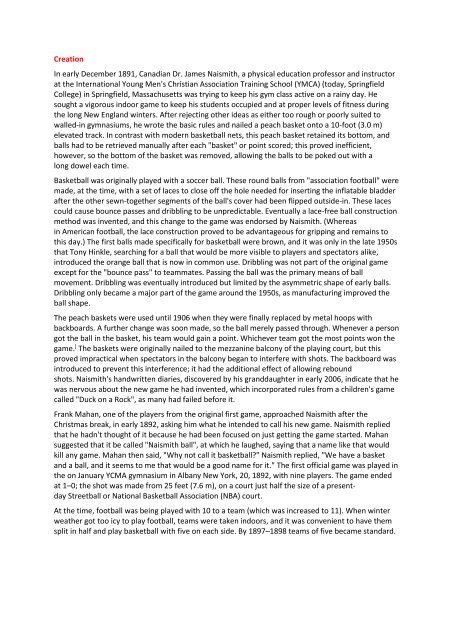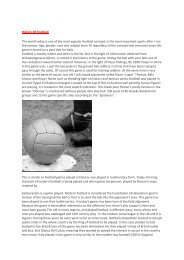Dergi
Create successful ePaper yourself
Turn your PDF publications into a flip-book with our unique Google optimized e-Paper software.
Creation<br />
In early December 1891, Canadian Dr. James Naismith, a physical education professor and instructor<br />
at the International Young Men's Christian Association Training School (YMCA) (today, Springfield<br />
College) in Springfield, Massachusetts was trying to keep his gym class active on a rainy day. He<br />
sought a vigorous indoor game to keep his students occupied and at proper levels of fitness during<br />
the long New England winters. After rejecting other ideas as either too rough or poorly suited to<br />
walled-in gymnasiums, he wrote the basic rules and nailed a peach basket onto a 10-foot (3.0 m)<br />
elevated track. In contrast with modern basketball nets, this peach basket retained its bottom, and<br />
balls had to be retrieved manually after each "basket" or point scored; this proved inefficient,<br />
however, so the bottom of the basket was removed, allowing the balls to be poked out with a<br />
long dowel each time.<br />
Basketball was originally played with a soccer ball. These round balls from "association football" were<br />
made, at the time, with a set of laces to close off the hole needed for inserting the inflatable bladder<br />
after the other sewn-together segments of the ball's cover had been flipped outside-in. These laces<br />
could cause bounce passes and dribbling to be unpredictable. Eventually a lace-free ball construction<br />
method was invented, and this change to the game was endorsed by Naismith. (Whereas<br />
in American football, the lace construction proved to be advantageous for gripping and remains to<br />
this day.) The first balls made specifically for basketball were brown, and it was only in the late 1950s<br />
that Tony Hinkle, searching for a ball that would be more visible to players and spectators alike,<br />
introduced the orange ball that is now in common use. Dribbling was not part of the original game<br />
except for the "bounce pass" to teammates. Passing the ball was the primary means of ball<br />
movement. Dribbling was eventually introduced but limited by the asymmetric shape of early balls.<br />
Dribbling only became a major part of the game around the 1950s, as manufacturing improved the<br />
ball shape.<br />
The peach baskets were used until 1906 when they were finally replaced by metal hoops with<br />
backboards. A further change was soon made, so the ball merely passed through. Whenever a person<br />
got the ball in the basket, his team would gain a point. Whichever team got the most points won the<br />
game. ] The baskets were originally nailed to the mezzanine balcony of the playing court, but this<br />
proved impractical when spectators in the balcony began to interfere with shots. The backboard was<br />
introduced to prevent this interference; it had the additional effect of allowing rebound<br />
shots. Naismith's handwritten diaries, discovered by his granddaughter in early 2006, indicate that he<br />
was nervous about the new game he had invented, which incorporated rules from a children's game<br />
called "Duck on a Rock", as many had failed before it.<br />
Frank Mahan, one of the players from the original first game, approached Naismith after the<br />
Christmas break, in early 1892, asking him what he intended to call his new game. Naismith replied<br />
that he hadn't thought of it because he had been focused on just getting the game started. Mahan<br />
suggested that it be called "Naismith ball", at which he laughed, saying that a name like that would<br />
kill any game. Mahan then said, "Why not call it basketball?" Naismith replied, "We have a basket<br />
and a ball, and it seems to me that would be a good name for it." The first official game was played in<br />
the on January YCMA gymnasium in Albany New York, 20, 1892, with nine players. The game ended<br />
at 1–0; the shot was made from 25 feet (7.6 m), on a court just half the size of a presentday<br />
Streetball or National Basketball Association (NBA) court.<br />
At the time, football was being played with 10 to a team (which was increased to 11). When winter<br />
weather got too icy to play football, teams were taken indoors, and it was convenient to have them<br />
split in half and play basketball with five on each side. By 1897–1898 teams of five became standard.




